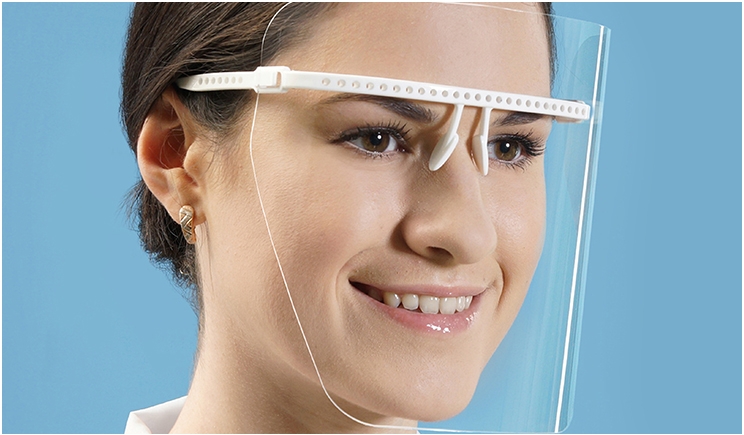
The facial protection that dentists wear can impact communication, increasing the levels of anxiety that patients with special needs may feel. To improve the dental experience for these patients, researchers from the Sussex Community National Health Service Foundation Trust and the Brighton and Sussex Medical School in England surveyed a sample of 72 Special Care Dentistry patients to see which types of facial protection they preferred on their dentist and how such gear affected their levels of anxiety.
According to the survey, 68% of the patients preferred use of a visor alone, while 22% chose the mask alone. The remaining 10% selected a combination of a mask and visor. The researchers also found that patients with higher anxiety levels were more likely to believe that the type of facial protection that the dentist wears would affect their anxiety. Overall, patients commented that a visor provides more benefits related to nonverbal communication. Robert Emanuel, BDS, MSc, corresponding author of the study, discussed these findings with Dentistry Today.
Q: What is Special Care Dentistry?
A: The United Kingdom’s Specialist Advisory Committee for Special Care Dentistry states:
“Special Care Dentistry provides preventive and treatment oral care services for people who are unable to accept routine dental care because of some physical, intellectual, medical, emotional, sensory, mental, or social impairment, or a combination of these factors. Special Care Dentistry is concerned with the improvement of oral health of individuals and groups in society who fall within these categories. It requires a holistic approach that is specialist led in order to meet the complex requirements of people with impairments.”
This pretty much sums up what the specialty involves. The key phrase is holistic approach. In this instance I would define holistic approach as looking at patients in their entirety including their social circumstances, cultural values, ability to get around, ability to understand and consent to dental treatment being offered, reliance on caregivers and family to support their oral care, and not just the biological factors involved in their dental treatment.
This is not to be confused with the use of complementary or alternative therapies such as homeopathy, which can sometimes also be labelled holistic care.
Q: What kinds of special needs did the patients in the study have?
A: The patients had a wide range of different disabilities including physical disabilities, dental phobia, and medical problems. Patients with learning disabilities who were unable to give their own consent were excluded due ethical reasons.
Q: What are the chief causes of their dental anxiety?
A: Dental anxiety can be caused by a number of different factors including past negative experience; fear passed on by family members to other, normally younger family members; as well as cultural stereotyping. In popular culture the dentist is often (but not always!) represented as a person who inflicts pain on patients and is either rather indifferent to their suffering or in some cases actually enjoying it. Perhaps part of the reason people fear the dentist is that by laying back in a chair with your mouth open, you can feel particularly vulnerable.
Q: How can the choice of facial protection make this anxiety better or worse?
A: Prior to the study, we felt that use of the traditional dental face mask had potential to limit nonverbal communication if the dentist talked to the patient whilst still wearing it. This can in our view cause not only problems conversing with patients who themselves may have communication problems, but also perhaps hinder the person from reading the dentist’s expressions to help them perhaps better understand the dentist’s mood. A dentist smiling warmly has the potential to allay fear in a patient. This can prevent the patient from wondering what the dentist’s face is doing behind the mask. Smiling? Scowling? Grimacing?
Q: Why was the visor preferable for those patients who chose it?
A: All patient groups when asked preferred the visor to the face mask only or face mask/visor combination, and comments around allowing better nonverbal communication were common, as we thought might have been the case when planning the study. In the higher anxiety group, the preference for using the visor was even stronger than in the lower anxiety groups. Most dentists, I believe, are friendly and caring, and they will communicate this to the patient via both verbal and nonverbal communication.
Q: Why was the mask preferable for those patients who chose it?
A: Some patients commented that they preferred the dentist to wear a mask because they felt it was necessary for cross infection control. It was also felt to be an integral part of the “medical” environment.
Q: How can dentists incorporate this information into their daily practices?
A: Dentists can make the choice of whether they use a visor only or a mask with or without a visor or other type of eye protection in their practice. What was interesting was that the choice of wearing a face mask only was not a choice you’d normally consider, as eye protection is considered essential. Therefore, wearing a mask would normally be supplemented by some kind of eye protection too. The face mask and visor combination was a clear third choice.
From our review of the literature, the jury appeared to be out on the effectiveness of the traditional face masking in reducing cross infection, which is perhaps the main reason we are taught to wear face masks when starting out. Therefore, we feel that by avoiding using a face mask, but using a clear visor to deflect any large droplets, we can provide care in such a way as to increase nonverbal communication and hopefully minimize the anxiety patients feel when attending dental care appointments.
Related Articles
Kit Teaches Children with Special Needs About Oral Health
What You Wear Can Ease Pediatric Dental Anxiety
Therapy Dog Joins the Staff at Pediatric Dental Practice











